Subscribe to Baseball History Comes Alive! for automatic updates (sign-up block found in right side-bar)
As a Free Bonus for subscribing, you’ll get instant access to my two Special Reports: Memorable World Series Moments and Gary’s Handy Dandy World Series Reference Guide!
1926 World Series Photo Gallery
Click on any image below to see photos in full size and to start Photo Gallery:
The Classic 1926 World Series: “Ol’ Pete” Alexander Comes to the Rescue!
With the start of the 2020 World Series just around the corner, my tour through the World Series stops today in the exciting 1926 World Series, one of the most memorable in the history of the Fall Classic.
It’s usually remembered for “Ol’ Pete” Alexander coming in relief – possibly nursing a hangover – to strike out Tony Lazzeri with the bases loaded and nailing down the Cardinal victory in Game Seven. It’s also remembered for Babe Ruth’s ill-advised attempt to steal second base that ended the Series.
In the featured photo, we see a beautiful colorization by our resident baseball artist, Don Stokes, of the two megastars of the 1920s who faced off in the 1926 World Series: Rogers Hornsby and Babe Ruth.
Also below is another colorization by Don of Pete Alexander. From the look on his face, I’d say Alex wasn’t feeling too good. Maybe this is what he looked like when Hornsby called him into the seventh inning of Game Seven.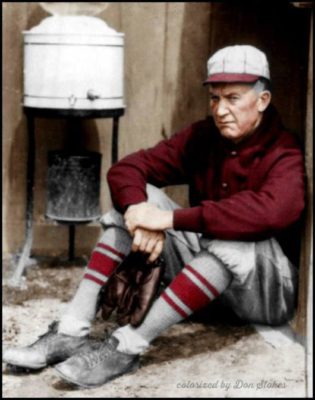
At the bottom of the post is a great team photo of the 1926 Yankees. I did player ID’s on this one a few years ago. Before looking at the identifications, take a good look and see how many names you can come up with.
Anyway…here’s a few words about this exciting World Series:
The 1926 World Series
The Series pitted the National League champion Cardinals (89-65), managed by Rogers Hornsby, against Miller Huggins’ American League champion Yankees (91-63) with the Cardinals winning four-games-to-three. The Series took place from October 2 to 10, 1926 at Yankee Stadium and Sportsman’s Park.
This was the first World Series appearance for the Cardinals, and the first of eleven World Series championships; while the Yankees were in their fourth World Series in six years and looking for their second championship. In Game One, Herb Pennock pitched the Yankees to a 2–1 win, while in Game Two, Pete Alexander evened the Series with a 6–2 Cardinal victory. Knuckleballer Jesse Haines’ shutout in Game Three gave the Redbirds a 2–1 Series lead.
In the Yankees’ 10–5 Game Four win, Babe Ruth hit three home runs, a World Series record equaled only four times since. This was the Series featuring the famous “Johnny Sylvester home run call.” According to newspaper reports, the Babe had promised the sickly boy he’d hit a home run for him. True to script, after his three-homer game, the boy’s condition miraculously improved. The newspaper account of the story is disputed by many contemporary baseball historians. It sounds more like a Christy Walsh p.r. stunt, but it remains one of the most beloved tales in baseball lore.
“Hero with a Hangover”: Was “Ol’ Pete” Sleeping One Off When He Got the Call?
Game Seven is remembered as the famous game in which manager Hornsby called upon Ol’ Pete in the bottom of the seventh inning. With two outs and the bases loaded, the Cardinals were clinging to a 3-2 lead with the dangerous Tony Lazzeri at the plate. There’s been an on-going debate over the years as to whether Alexander was nursing a hangover in the bullpen when Hornsby made the call.
And who could blame him? After all, he had already pitched two complete games in the Series, including one just the day before in Game Six, and so wasn’t expecting to appear in Game Seven. But Rajah apparently had other plans. Pete was probably minding his own business, peacefully “sleeping one off” in a corner of the bullpen when his slumber was rudely awakened by Hornsby’s call. The discussion in the bullpen that day may have gone along something like this:
Cardinals’ coach Bill Killefer: “Pete!…Get up!…Now!…Rajah wants you to come in and pitch to Lazzeri!”
Pete: “Huh??…Wha’d ya’ say??…Hornsby wants me to do wha’…??”
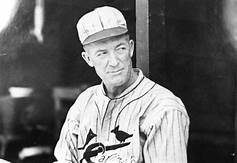
Killefer: “That’s right…He wants you to come in and pitch to Lazzeri! Pull yourself together…Put that bottle of hooch down!…Start warming up! Pronto!”
Alexander sauntered in from the bullpen with his long, slow strides. After a few warmup tosses, he proceeded to strike Lazzeri out after Tony hit a long foul shot to left that just missed leaving the yard. Pete then held the Yankees scoreless over the next two innings to preserve the win. The Cards had their first World Series Championship. Ol’ Pete had answered the call – hangover or no hangover – and Hornsby looked like a genius.
Babe Ruth Out at Second By 10 Feet to End the Series!
Also in the decisive Game Seven, the Yankees were trailing 3–2 in the bottom of the ninth with Alexander still on the mound hoping to close out the victory. The Bronx Bombers were down to their last out. Ruth walked, bringing up Bob Meusel, a .315 hitter that year. Meusel also had success in Game Six against Alexander, with a double and triple. As he stood at the plate
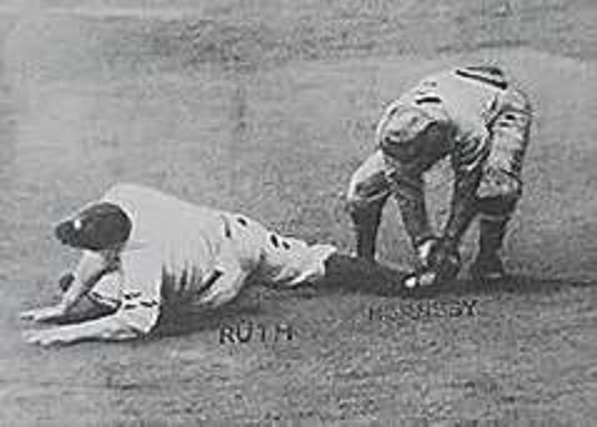
awaiting the first pitch, Ruth made the bold move of trying to steal second. Meusel swung and missed, and Cardinals’ catcher Bob O’Farrell threw a strike to second baseman Hornsby who easily laid the tag on the sliding Bambino. He was out by a good 10 feet. The game – and the World Series – was over.
As Hornsby recalled later, “Ruth didn’t say a word. He didn’t even look around or up at me. He just picked himself up and walked away.” It’s still the only time a World Series has ended with a runner being caught stealing. Ruth later offered this explanation for his ill-advised attempted steal: “I didn’t think anyone would expect it. If I got to second safely, I’d have an easier chance to score on a single.” He was right, but unfortunately for the Yankees, it didn’t work out the way he planned.
Such was the acclaim Rogers Hornsby received for this exciting upset World Series victory over the Yankees, that it propelled him into a long managerial career, allowing him to milk the championship for
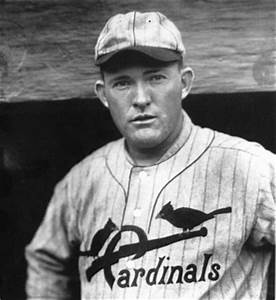
all it was worth. Even though he had little success as a manager in the ensuing years, with the 1926 season being his only pennant and World Series championship, he was still getting jobs into the 1950s.
Over 14 seasons at the helm of various teams, he posted a 701-812 (.463) record. Granted, six of the seasons were managing the lowly St. Louis Browns, with whom no one had success. Such was Hornsby’s abrasive personality that Cub president William Veeck, Sr. once proclaimed that hiring Hornsby to manage the Cubs was the biggest mistake he ever made in his long career as a baseball executive. He actually fired Hornsby in 1932 while the Cubs were in first place. Incredibly, his son, Bill Vecck, Jr., made the same mistake in 1952 when he hired Hornsby to manage the Browns. He later expressed the same regret as his father when he fired Rajah, much to the great relief of the Browns’ players.
HALL OF FAMERS
The 1926 World Series featured a multitude of future Hall-of-Famers: Cardinals’ Grover Cleveland Alexander, Jim Bottomley, Chick Hafey, Jesse Haines, Rogers Hornsby, Billy Southworth; Yankees Miller Huggins, Earle Combs, Lou Gehrig, Tony Lazzeri, Herb Pennock, Babe Ruth, Waite Hoyt; plus Umpires Bill Klem and Hank O’Day.
1926 YANKEES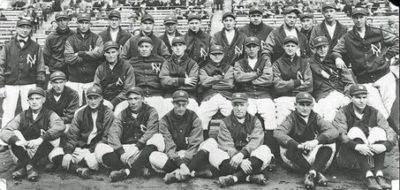
How many did you get?
Top Row, L-R: Doc Woods (Trainer), Fred Merkle, “Sad” Sam Jones, Earle Combs, Aaron Ward, Bill Skiff, Waite Hoyt, Tony Lazzeri, Babe Ruth, Lou Gehrig, Miles Thomas, Herb McQuade, “Jumpin’ Joe” Dugan. Middle Row, L-R: Mark Koenig, Pat Collins, Benny Bengough, Miller Huggins (Mgr.), Walter Beall, Herb Pennock, Bob Meusel. Front Row, :L-R: John Barnes, Spencer Adams, Urban Shocker, Ben Paschal, Garland Braxton, Charlie O’Leary (Coach), Mike Gazella, Bob Shawkey.
Gary Livacari
Photo Credits: Colorizations by Don Stokes; All others from Google search
Information: Excerpts edited from 1926 Wikipedia page
Check out my latest book, recently nominated for the SABR 2020 Lawrence Ritter award: Reflections On the 1919 Black Sox: Time to Take Another Look now available on Amazon in e-book and paperback. All profits go to the Illinois Veterans Foundation
Vote In Our New Poll: How Do You Feel About New Rules Changes?
We are a participant in the Amazon Services LLC Associates Program, an affiliate advertising program designed to provide a means for us to earn fees by linking to Amazon.com and affiliated sites. Click here to view Amazon’s privacy policy
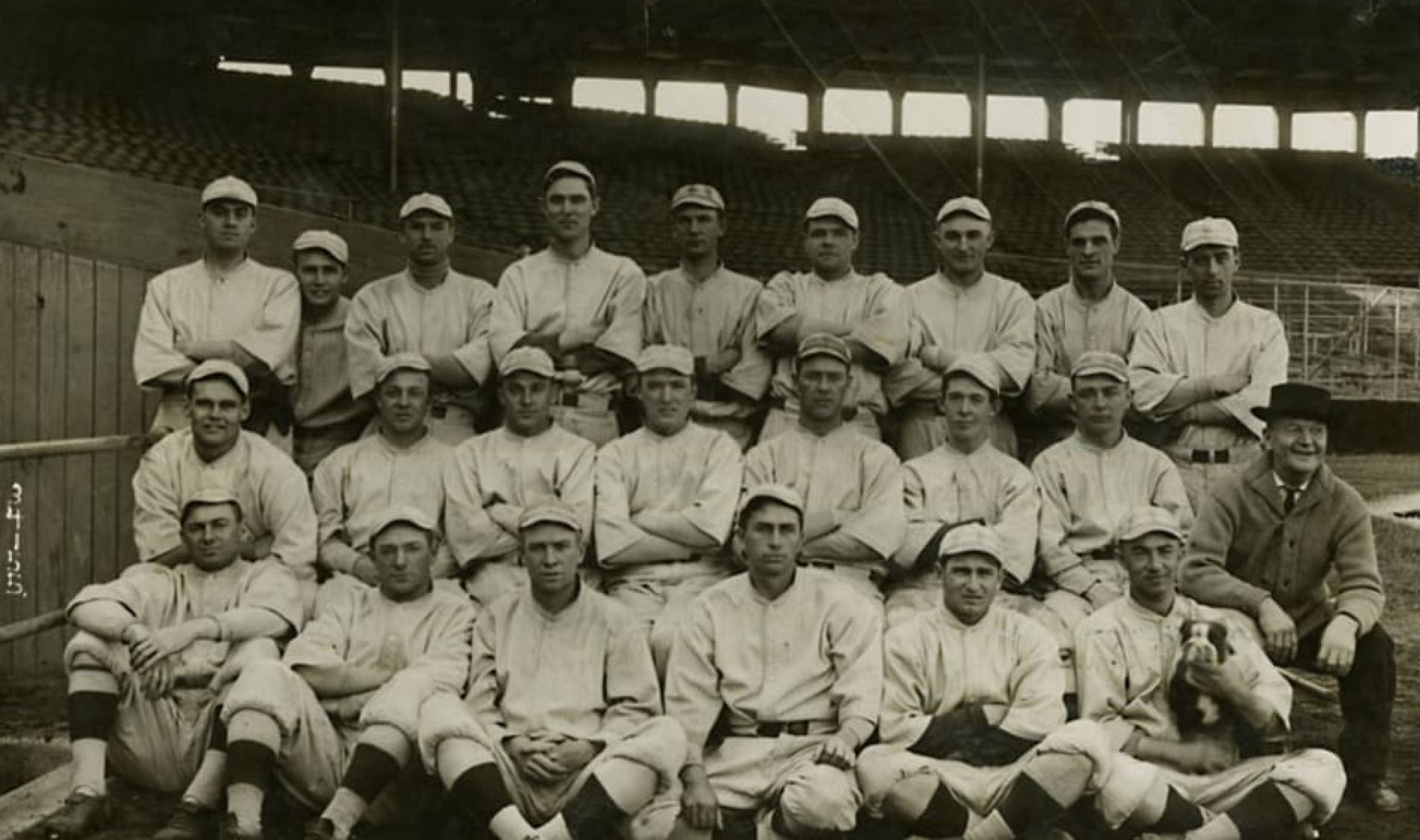
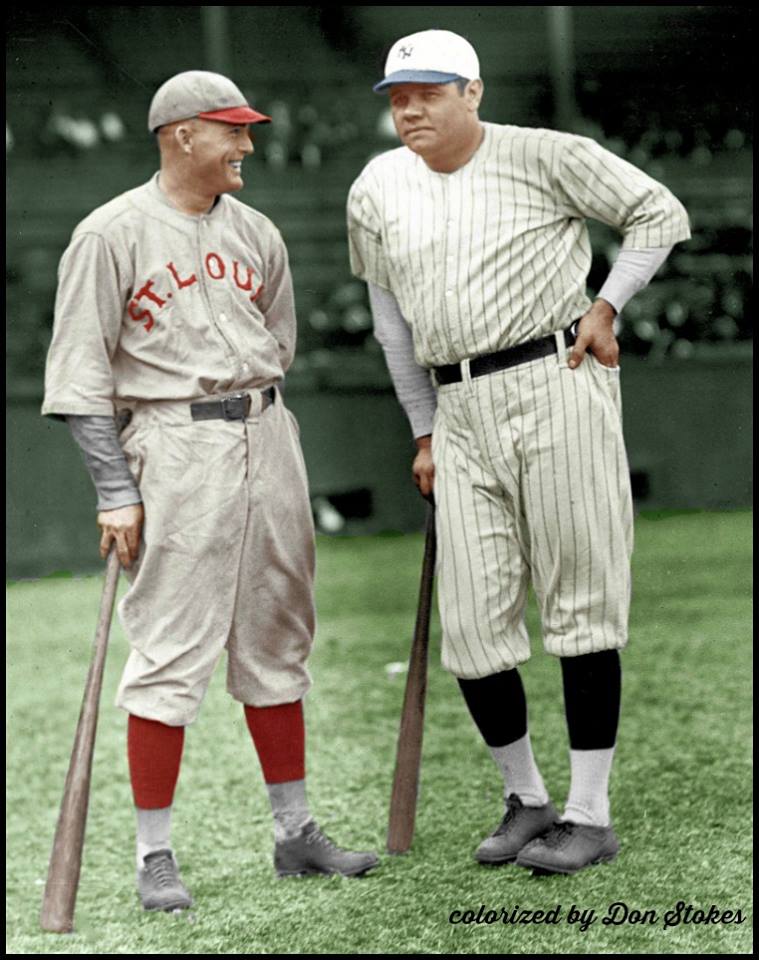
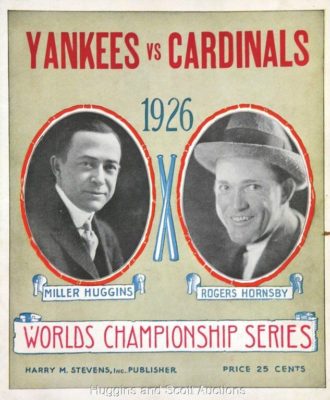
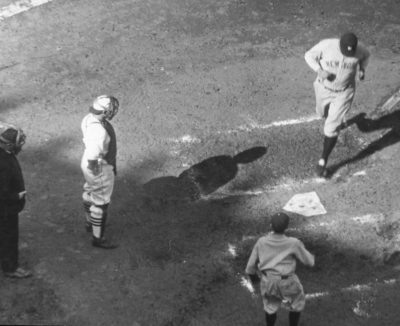
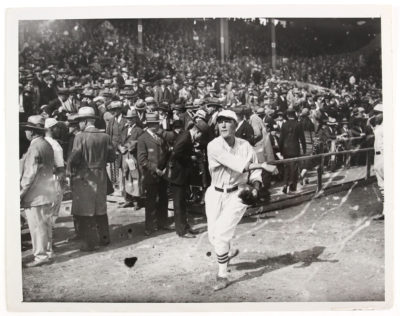
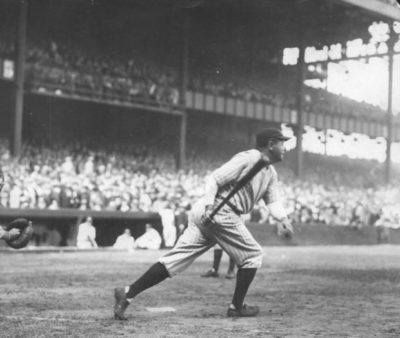
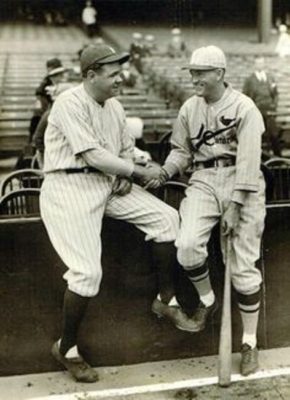
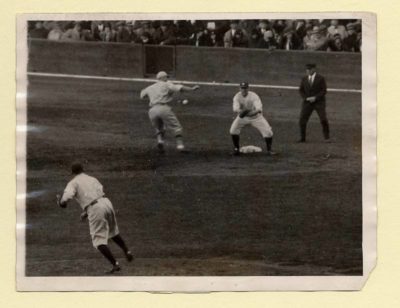
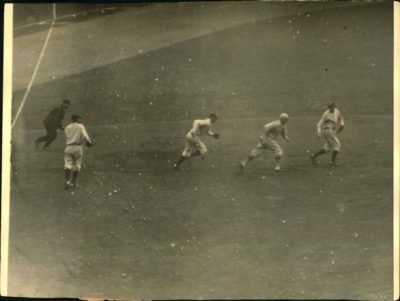
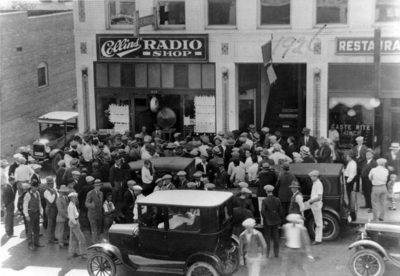
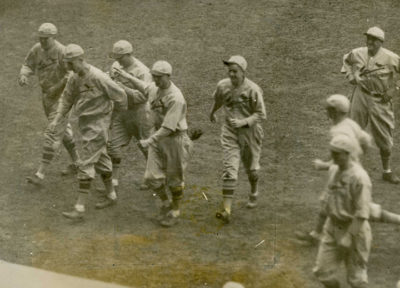
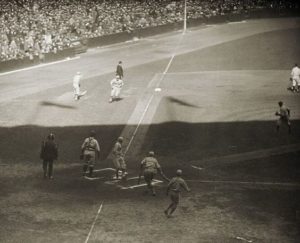
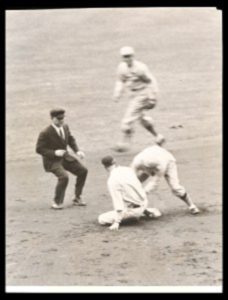
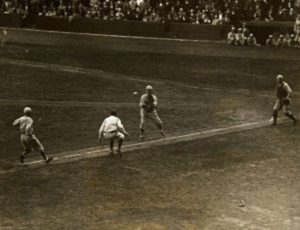
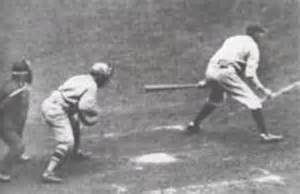
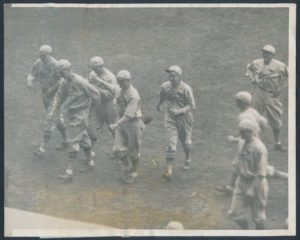
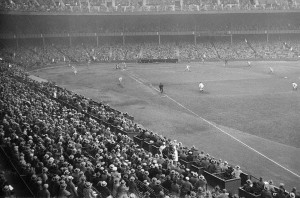
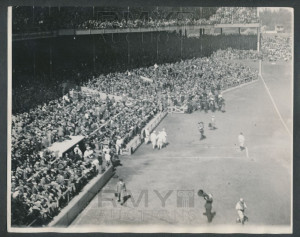
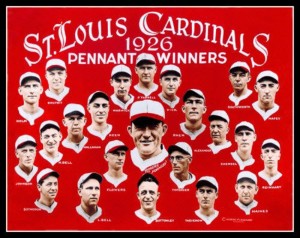
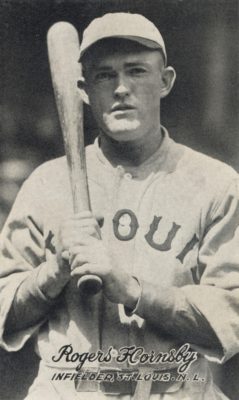
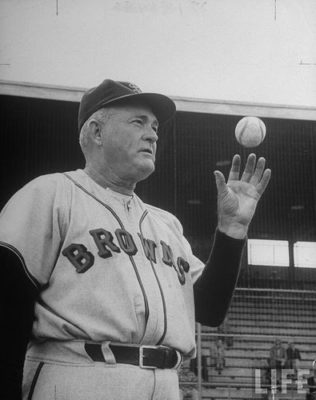
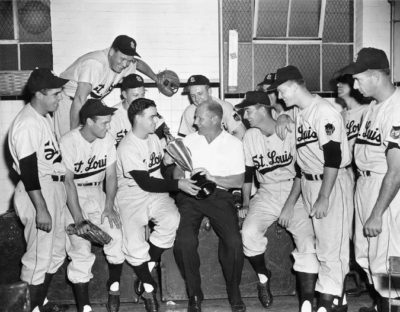
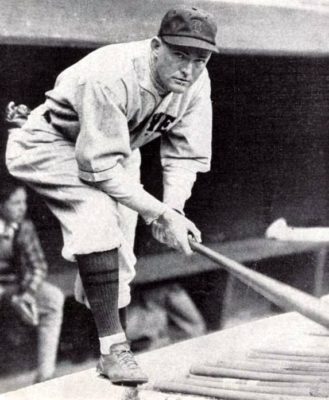
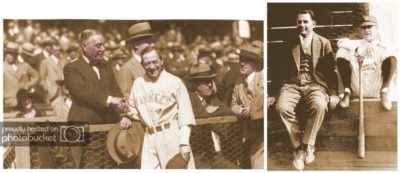
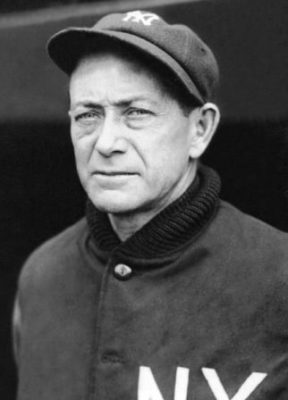
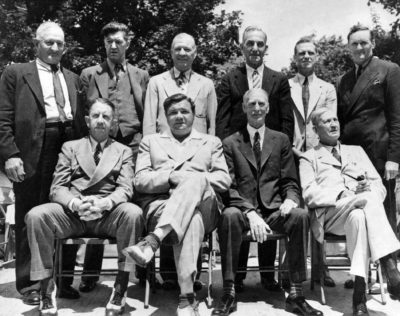
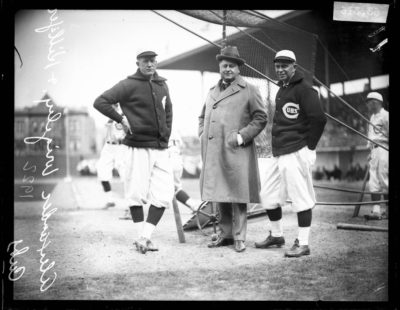
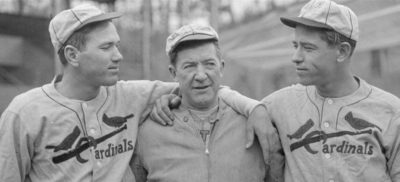
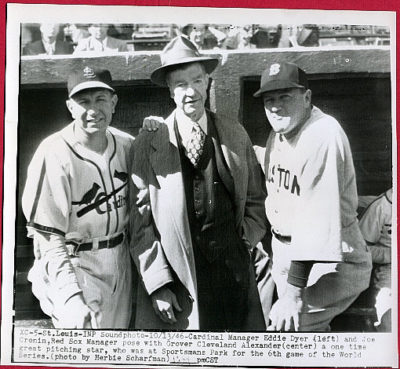

Thanks for such an interesting look back on a classic Series, Gary.
Immediately “The Winning Team” (’52) comes to mind, with Reagan portraying Alexander, Doris Day, as his lovely wife and Frank Lovejoy playing the kindest, gentlest Raja Hornsby you ever saw!
So corny, but still enjoyable and loaded with real major league ball players (and you can probably identify all of them!)
Best, Bill
Bill would have mentioned this if he hadn’t run out of room, but how many major leaguers were named after one president and portrayed by another on the big screen? Only one from Nebraska, I’ll warrant.
I have never understood how Old Alec managed to reel off 190 Ws in his first seven seasons, including a rookie-record 28 in 1911, and 31-33-30 from 1915-’17. One wonders what his records would have looked like if not for WWI, where he was gassed and shell-shocked before returning to baseball. As it was, Alexander set NL records for games won (tied at 373 with Christy Mathewson, another mustard-gas victim) and shutouts (90), to say nothing of posting a mind-altering 437 complete games.
Stats like these are the stuff that HOF plaques are made of. Small wonder that Alec’s remarkable life story caught the imaginations of movie moguls following his death 70 years ago.
Thank you, Gary, for another very enlightening and memorable post. (Lest we forget!)
Baseball professor emeritus Michael Keedy makes a good point about the amazing stats of Grover Cleveland. And it is remarkable he lasted so long given his maladies.
Alexander’s double whammy of mustard gas/shell shock actually triggered epilepsy, which, in turn, exacerbated his alcoholism.
In the movie, the emphasis was a little more on the other factors and a bit less on alcohol–in keeping with the slight sugar coating of a hero. Ronald Reagan was a very sympathetic dipso and Frank Lovejoy rivaled Ralph Kramden as “The Sweetest Guy in the World” rather than portray the real, irascible Rogers Hornsby. But they were both so nice who’s complaining?
Plus, scanning the stands from the mound and seeing the lovely Doris Day smiling at you would inspire anybody!